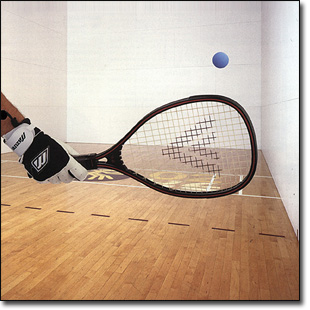Diagnosis
(Page 1)
The History
For the better part of my life I tried to lead a fairly healthy and active lifestyle. I would not consider myself a ‘jock’, but I tried to stay healthy by eating sensibly and staying fit. In high school I played volleyball, rugby, lifted weights, and ran track among other sports. I would continue these extracurricular activities into my college years, and when the free college gym membership ran out, I joined a health club in 1990 to get access to weight machines and racquetball courts.
For the next several years I would follow a rigorous workout routine that included 1 1/2 hours of weight-lifting every Tuesday, Thursday, and Saturday, and a cardiovascular racquetball workout every Monday and Wednesday. Of all the sports I played, I enjoyed racquetball the most. There were approximately 15 of us who would meet twice a week and play singles/doubles matches until the club closed at 11pm. Because many were at the same playing level, the workouts were exhausting and after 3+ hours of play, I could ring out a cup of sweat from my t-shirt. Eventually my weekly weight-lifting regiment would be downgraded to sporadic, but I would religiously continue with racquetball for the next 15+ years.

Being very physical and feeling quite healthy, I was never much of a doctor guy. But as the years went on I would eventually force myself to get a physical once a year. It was around the year 2000 when my general practitioner detected a heart murmur and sent me to a cardiologist for further examination. During my Echocardiogram it was discovered that unlike most people who have a tricuspid (three leaflet) aortic valve, I had a bicuspid (two leaflet) valve. The cardiologist's diagnosis was that my heart murmur was caused by Aortic Regurgitation—a condition where the aortic valve is incompetent (does not completely close/seal), and blood flows passively back to the heart in the wrong direction. Following the diagnosis, I went through a series of stress tests that eventually concluded my condition was stable and I simply needed an annual Echocardiogram to make sure that my heart condition was not deteriorating.

Note 1) My bicuspid (two leaflet) valve is a congenital anomaly. Interestingly, my father was also diagnosed with a bicuspid valve years ago, but at the age of 73 his valve still seems to be functioning properly. Despite inheriting my bicuspid valve from my father, our health conditions took two different paths: although his valve is still working fine, at the age of 50 he was diagnosed with atherosclerosis and had a balloon inserted during an angioplasty operation to widen one of his 95% obstructed blood vessels. It would be a few years later that he would again undergo another angioplasty to widen a second 90% narrowed artery with a stent. Both operations were successful and now he follows up with a cardiologist annually to make sure that his atherosclerosis and his valve condition is not deteriorating.
Note 2) My heart murmur was first detected around the age of 10. According to my mother, I was experiencing some tonsil pain for which a local doctor in the rural town of Klodzko, Poland prescribed some antibiotics. I'm not sure how accurate my mother's recollection of my medical condition is, because I've recently learned that Rheumatic Fever — a complication of untreated strep throat — may have caused the calcification damage to my aortic valve. Rheumatic fever is an inflammatory disease that occurs following infections such as strep throat or scarlet fever, and typically appears in children between the ages of 5 through 15. In such cases the heart complications may be long-term and severe, particularly if valves are involved. If Rheumatic Fever was the cause of my valve damage, then that could explain my heart murmur that my mother insists was first detected following my hospital stay. BTW: According to my mother, gargling with salt water eventually cured my tonsil pain. Who would have thought...
